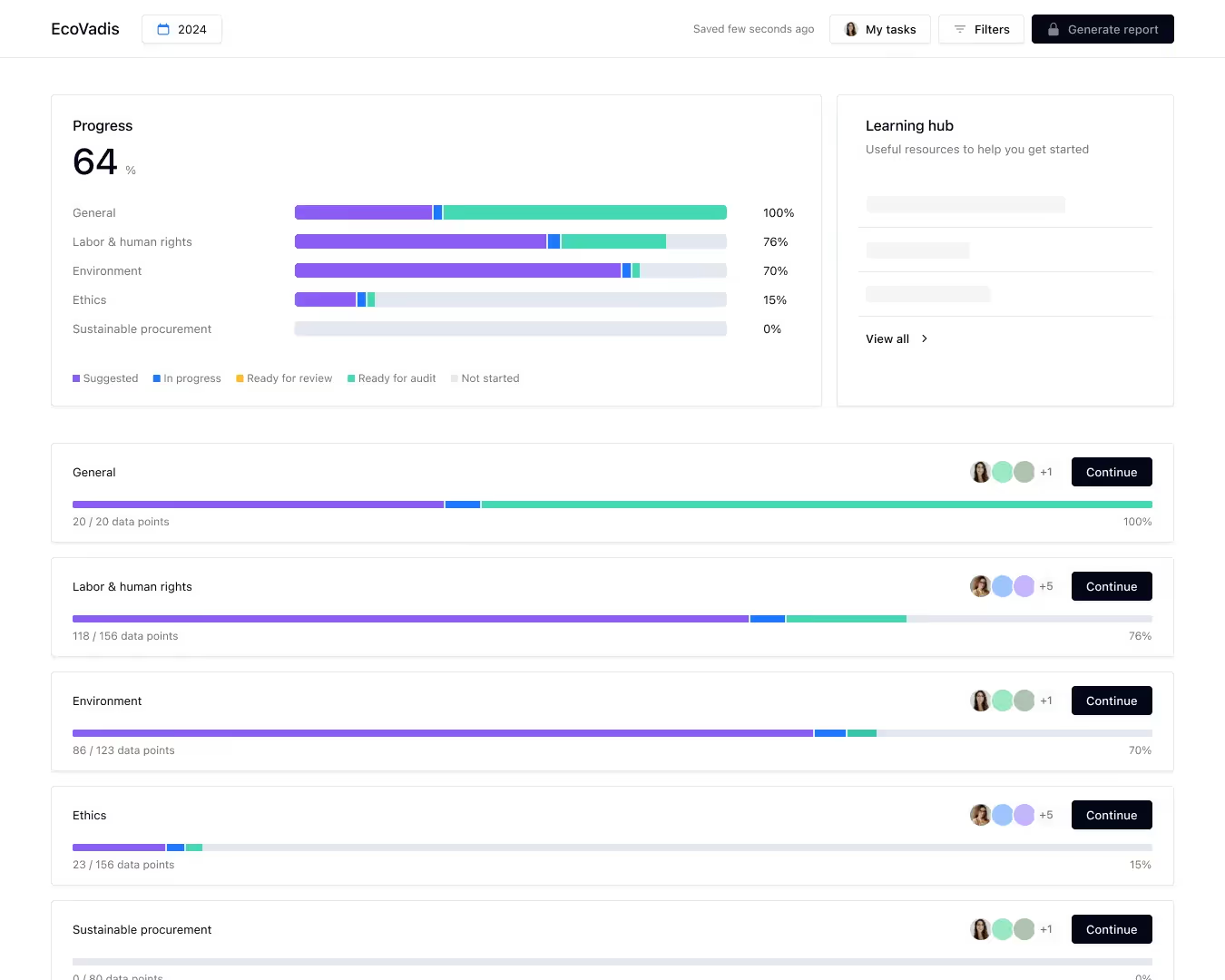
Disclaimer: Latest EUDR developments
On 21 October, the European Commission proposed targeted changes to the EU Deforestation Regulation (EUDR). These adjustments aim to make the rollout smoother without changing the regulation’s overall goals.
Key points from the proposal:
We're closely monitoring the development and will update our content accordingly. In the meantime, read the full explainer here.
The EcoVadis questionnaire is a documented audit of how your company manages sustainability. It evaluates real-world practices – not just written commitments – across four categories: Environment, Labor & Human Rights, Ethics, and Sustainable Procurement.
To score well, companies must go beyond policy statements. EcoVadis looks for proof that policies are implemented and deliver measurable results. Analysts only credit answers backed by clear, relevant documentation.
Scoring reflects this focus: around 25% of points come from policies, 40% from actions, and 35% from results. That means a signed policy is useful – but evidence of training, procedures, or performance improvements carries more weight.
A Platinum rating – reserved for the top 1% of companies – requires strong documentation across all four themes. A weak score in just one area (below 30/100) disqualifies medal eligibility entirely. We explain the further ratings in this article.
The EcoVadis questionnaire is customized based on your company’s size, industry, and operating locations. A manufacturer might get more questions on pollution or energy, while a small services firm may see fewer environmental criteria. In total, it covers up to 21 sustainability criteria across four core themes:
{{custom-cta}}
Each question falls under one of seven management indicators:
Each question includes multiple best-practice option statements. You select the ones that apply and upload supporting documents for each. Only attached documents are reviewed by EcoVadis analysts – unchecked options or unsupported claims won’t count.
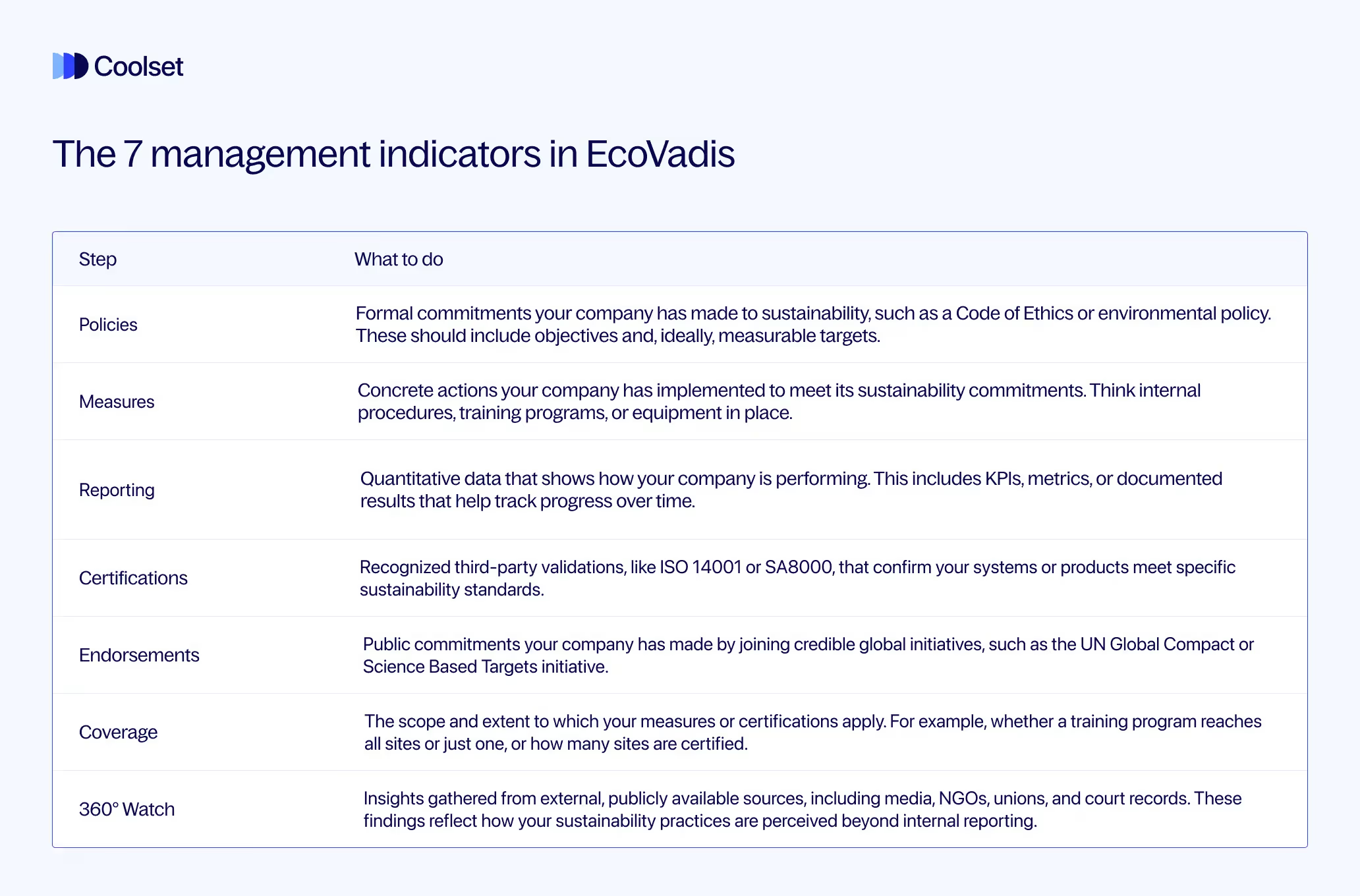
You can submit up to 55 supporting documents per assessment. That’s total, not per theme. Documents must be relevant, recent, and standalone. Do not merge unrelated files into a single upload – EcoVadis explicitly warns against “combined documents” and may reject them outright.
A smart approach is to reuse high-quality documents across multiple questions. For example, a sustainability report could support answers in all four themes – just reference the relevant page numbers when attaching it.
EcoVadis doesn’t let you pick your own questions. You receive a predefined set of questions based on your company’s size, industry, and location. From there, you select only the options that apply to your business – usually by marking “yes” and attaching supporting documents.
Some criteria may not be relevant. For example, a software company might see a question about biodiversity but have no activity in that area. In these cases, you can leave the option unchecked, select “not applicable” if available, or add a brief comment explaining why it doesn’t apply.
Skipping options that don’t fit won’t hurt your score. EcoVadis focuses on the material risks for your sector, not whether you respond to every line item. The goal is to show evidence for what you do have in place – not to pad your answers with irrelevant claims.
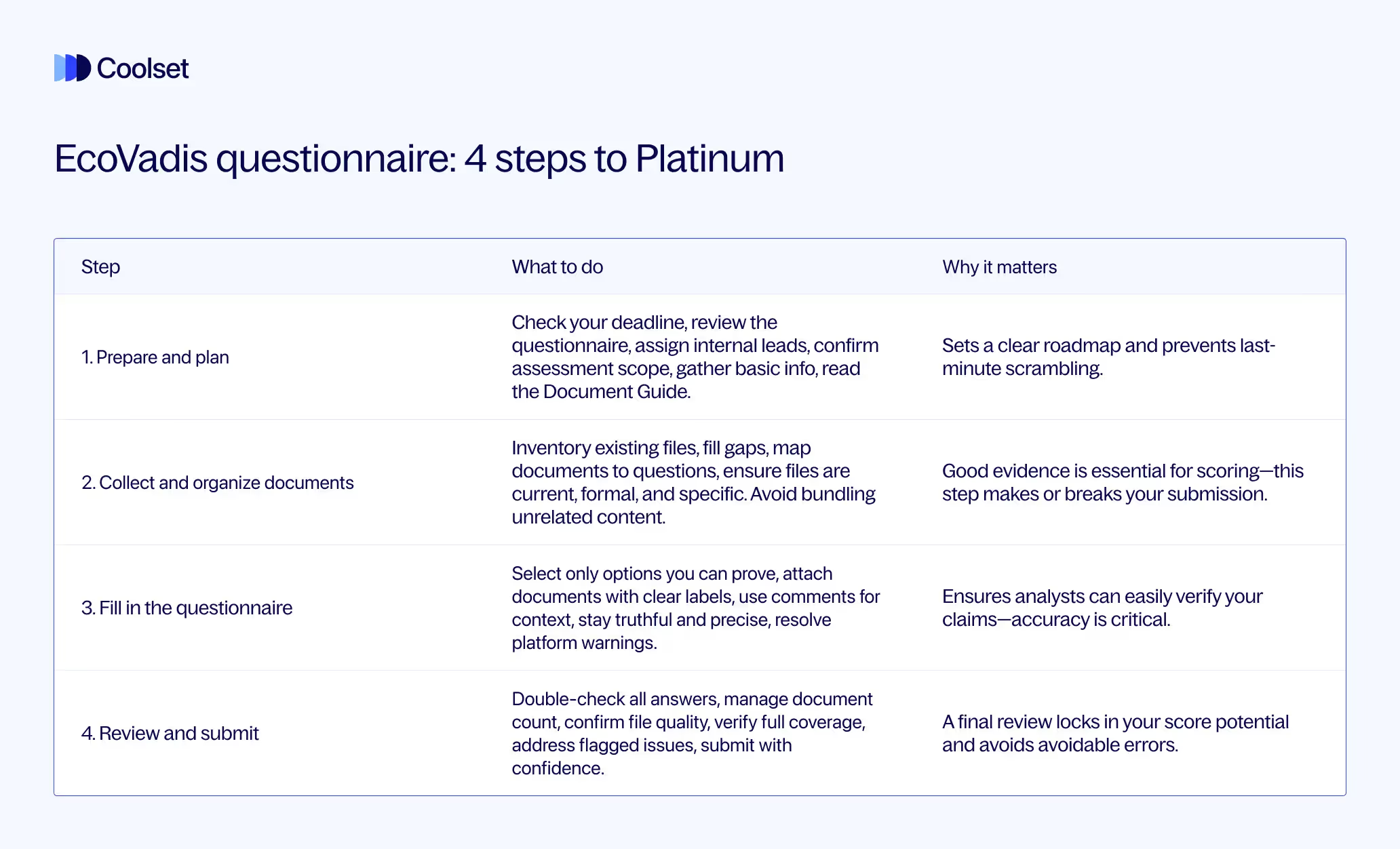
Filling out the EcoVadis questionnaire can feel daunting, especially if it’s your first time or you’re aiming for a top score. Breaking it down into clear steps will help. Below is a step-by-step process – from preparation to submission – to guide you through completing the questionnaire successfully.
Start by checking your submission deadline – EcoVadis usually gives 30 business days from the date you receive your questionnaire. Plan backward from that date and build in a buffer for document reviews or internal delays. After submission, it typically takes 6 to 8 weeks to receive your scorecard.
Next, get familiar with the questionnaire layout. You can download the Excel version to share and draft responses offline, or explore the online interface directly.
As you review the questionnaire, pay attention to which sections are activated based on your company’s size, industry, and location. These factors determine the specific criteria that apply – and where supporting documents are expected.
Then, assign internal leads by theme. For example, HR can support labor-related content, compliance can handle ethics, and procurement can address supplier oversight. Even if you’re coordinating solo, make sure you know where to source documents from each team.
Clarify your assessment scope. EcoVadis evaluates a specific entity – often your legal unit, not the entire group. If you plan to use a group-level policy or sustainability report, make sure it’s clear that the content applies to the assessed entity. If not, it may not be scored.
You’ll also need to answer basic questions about your company’s size, structure, and any external sustainability commitments (like the UN Global Compact or Science Based Targets). Have supporting documents on hand – certificates, listings, or screenshots that confirm your participation.
Finally, read the official EcoVadis Document Guide. Pay close attention to document age, formatting, and why combining unrelated files is discouraged. Aim for a small set of high-quality, relevant documents – EcoVadis gives you a 55-file limit, so use it strategically.
If you’re still unsure, check the EcoVadis Help Center or consider using tools like Coolset to help streamline the process. But with preparation, most mid-sized companies can handle this step internally.
Documentation is the backbone of the EcoVadis questionnaire. You’ll spend most of your time here – and it’s time well spent. Here’s how to tackle it efficiently.
Build an inventory of potential evidence across all four themes. Focus on:
Don’t panic if something’s missing. You can formalize informal practices during this phase – as long as they reflect real activities. A short, signed policy written during the assessment period is valid. Just avoid placeholders, boilerplate templates, or backdating content.
If you have no data for a specific topic (e.g. no energy use tracking), you may need to mark that answer as “no mechanism in place.” Focus your time on the areas where you do have strong documentation.
Tip: It's common to use policies or reports from a corporate group, but if those documents don’t clearly reference your specific legal entity, EcoVadis may not accept them for scoring.
Use a spreadsheet to link each questionnaire option to one or more documents. Include:
This not only prevents gaps – it helps analysts quickly find the evidence. Rename files clearly (e.g. “Code of Ethics 2024 – Signed.pdf”) and use bookmarks or annotations to guide reviewers.
EcoVadis allows you to reuse a document across multiple answers without it counting against the 55-file limit. But each unique file counts once – so choose wisely.
Before uploading, make sure each document is:
Avoid generic templates and bundled files. EcoVadis explicitly rejects submissions where unrelated content is crammed into a single PDF. One exception: grouping similar evidence (e.g. several ISO certificates or KPIs by site) can be fine if clearly labeled.
The only valid exceptions are logical consolidations, like a batch of ISO certificates for multiple sites or a spreadsheet with KPIs from various locations. Even then, use these sparingly. In general, keep each file focused, clearly labeled, and relevant to one topic.
By the end of this step, you should have a clean set of well-chosen documents, a clear mapping of which document supports which questionnaire option (with page references), and confidence that your evidence touches all key areas. Now it’s time to head back into the platform and start filling in your answers.
By the end of this step, aim for:
This preparation makes filling out the questionnaire faster – and increases your chances of a platinum score.
With your documents ready, begin completing the questionnaire directly in the EcoVadis platform. It’s often best to work through one theme at a time – Environment, then Labor & Human Rights, Ethics, and Sustainable Procurement – to keep your focus aligned with the supporting materials.
For each question, read the help text provided by EcoVadis and review the list of option statements. Select only those you can fully support with evidence. If an option doesn’t apply, leave it blank or use the “No specific practice” or “Other” option – just be ready to explain in the comment box if needed. Don’t select an option unless you can back it with a credible, attached document. Analysts won’t credit claims without proof and may view unsupported selections as a red flag.
For each selected option, upload or link to the relevant document. Thanks to your prep, you should already know what to attach. If a file has been used before, reattach it from your library – it won’t count again toward the 55-document limit. Use the description field to guide the analyst: “See page 4 – section 2.3 outlines CO₂ target.” A brief label like “Signed environmental policy, includes 2025 goal” helps speed up review and ensures nothing gets missed.
Use the comment box to clarify anything that might need context. If a topic isn’t relevant to your business, explain why. For instance: “No water reduction programs in place as operations are limited to office environments.” If you choose “Other,” describe what the practice is and how it’s documented. But remember – comments don’t count as evidence unless a valid document is attached. Use them to support interpretation, not to substitute for proof.
EcoVadis analysts review submissions carefully and can cross-check your answers against external sources through the 360° Watch. Avoid over-claiming. If only half your workforce received ethics training, don’t select “All employees trained.” If a report says 35% women in management, don’t round it up to 50%. Inconsistencies like that can impact your score and trigger follow-up questions.
Some questions may feel out of reach – like carbon management or supplier oversight. If you’ve taken even partial steps, include them. For example, if you’ve tracked electricity usage but not full emissions, attach that energy data. If you added ESG clauses in supplier contracts but haven’t done audits yet, share a contract template. If you truly have no practices in place for a question, select “not in place” where available. It won’t earn points, but it’s better than guessing or overstating.
The EcoVadis interface will flag missing attachments, unanswered mandatory fields, or documents in the wrong format or language. Resolve these before submitting. Analysts rely on clear, relevant, and accessible evidence – any friction here can slow things down or lead to rejected answers.
Go in the order that makes sense for your team. Many companies start with Environment, then move to Labor & Human Rights, followed by Ethics and Sustainable Procurement. Take breaks between themes if needed, and involve colleagues when answers require their input. For example, check with your facilities or EHS manager before finalizing any emissions-related claims. Quick internal reviews like that can prevent costly mistakes later on.
Before hitting submit, take time to review your entire submission. This is your last chance to fix gaps, clarify evidence, and ensure your answers are as strong as possible.
Check that no required questions are left blank. EcoVadis marks some questions mandatory – especially those tied to high-risk areas. If you truly have no data, select the appropriate “No current practice” option and leave a short explanation in the comment box. Also scan for typos or inconsistent numbers in open text or data fields.
Review your document count. The platform shows how many unique files you’ve uploaded. If you’re near the 55-file limit, check for redundancies. Related content – like multiple one-page certificates – can sometimes be merged into a single PDF with clear labels (e.g. “ISO 14001 – Site 1 to 5”). Keep merged documents tightly scoped and easy to navigate.
If you’re well below 55, that’s fine – there’s no reward for hitting the cap. A tight, focused evidence set is often easier for analysts to score accurately.
Open several files to confirm they display correctly and aren’t corrupted. Make sure linked URLs are accessible and readable. If you referenced a specific page in your comment, verify that the page number still matches after conversion or upload.
Step back and check each theme. Did you cover all three pillars – Policy, Action, and Results?
If you missed one – for example, if your labor section has no KPIs – go back and see if a supporting document was overlooked. A missing file could cost you points unnecessarily.
Premium users can download their draft responses and share internally before submitting. You may also see warnings in the platform about missing or irrelevant documents – fix these before finalizing. A last-minute internal review from a colleague can catch issues you might miss.
When ready, navigate to “Check & Submit”. Once submitted, your answers are locked until your next cycle.
The analysis phase usually takes 6 to 8 weeks. During this time, EcoVadis analysts review your answers and documents – and run the 360° Watch, which scans for external news, controversies, or violations. If a major issue is flagged (e.g. legal action or environmental fines), it may impact your score – even if your internal answers were strong.
You’ll receive an email when your scorecard is ready. Log in to see your theme-by-theme performance, strengths, and areas for improvement. If you earned a medal – especially Platinum (top 1%), gold (top 5%) or silver (top 15%) – congratulations! If not, review the feedback carefully. Missing evidence is one of the most common reasons for lower scores.
By closing this step with care, you’ve not only completed the questionnaire – you’ve built a traceable, well-organized record of your sustainability efforts. Up next, we’ll dive deeper into the four EcoVadis assessment themes and what each one evaluates.
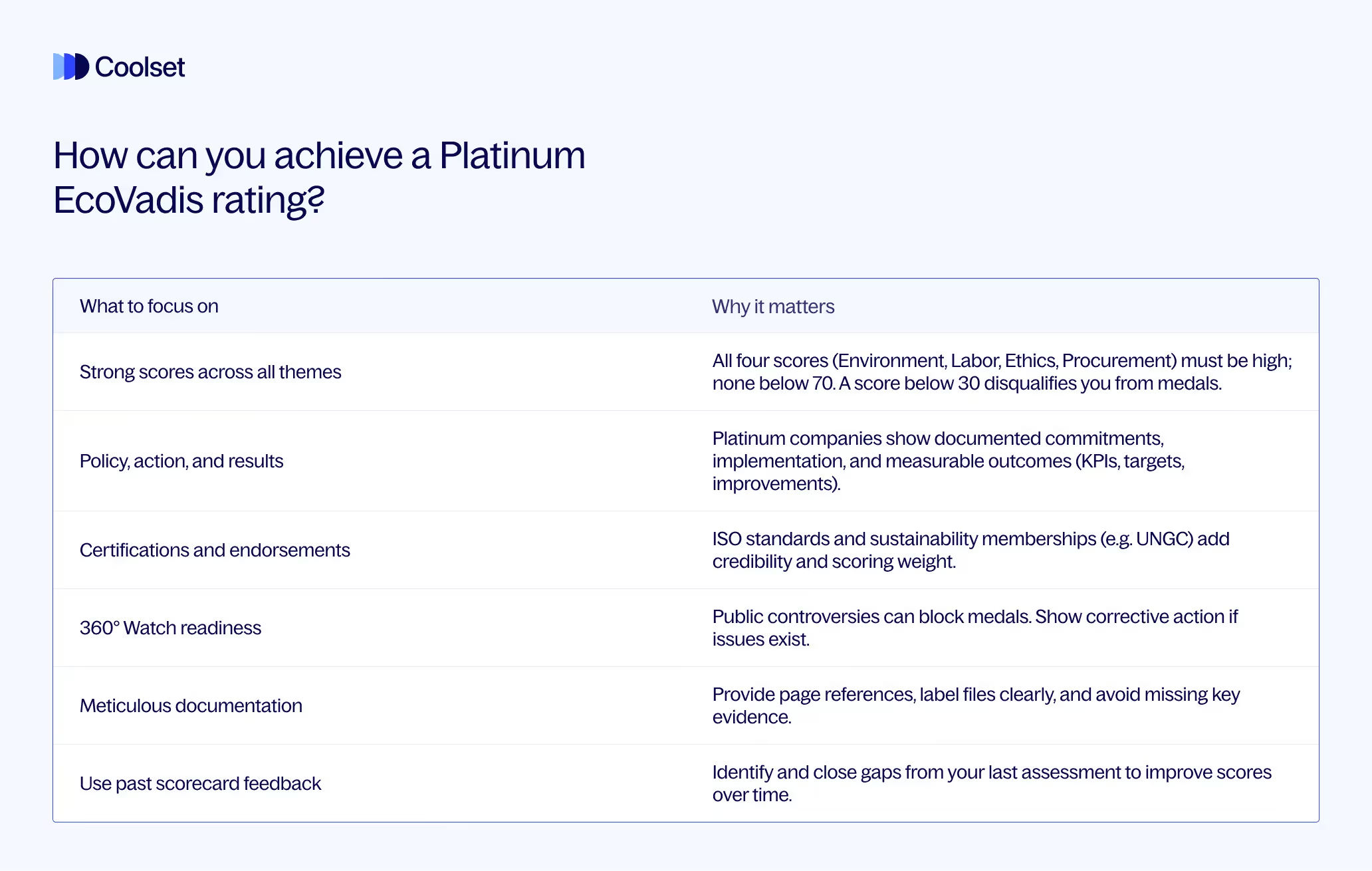
EcoVadis assesses sustainability performance across four categories – called “themes.” Each theme covers a broad set of criteria and contributes to your overall score. Here’s what each one includes:
This theme evaluates how your company manages its environmental impact. It covers areas like energy use, greenhouse gas emissions, water consumption, waste management, pollution control, and product environmental impacts.
EcoVadis looks for documented policies, climate targets, implementation measures, and reporting on key metrics (like CO₂ emissions or recycling rates). Companies in high-impact sectors – such as manufacturing, agriculture, or transport – typically face more extensive environmental questions, and this theme often carries more weight in the scoring for those industries.
This theme focuses on your company’s responsibility to provide fair, safe, and inclusive working conditions. It includes topics such as occupational health and safety, working hours, employee rights (like freedom of association), non-discrimination, training and development, diversity, and grievance mechanisms.
For larger businesses or those operating in higher-risk geographies, EcoVadis also looks at human rights due diligence – especially how risks are addressed in your operations or supply chain. Evidence should include signed policies, training records, and relevant workforce metrics like accident rates or turnover.
This theme assesses your company’s approach to ethical business conduct. It covers anti-corruption and bribery, anti-competitive behavior, fraud prevention, conflict of interest management, and data protection.
EcoVadis expects at least a basic Code of Ethics and Anti-Bribery policy, with evidence of how these are implemented – such as training programs, whistleblower systems, or compliance audits. In today’s context, it may also include cybersecurity and privacy practices as part of responsible information management.
This theme examines how you extend sustainability practices to your suppliers. It’s about making sure your supply chain upholds environmental, social, and ethical standards.
You’ll need to show whether you have a Supplier Code of Conduct, whether sustainability is factored into supplier selection and performance, and if suppliers are assessed, trained, or audited. Even small steps – like adding an ESG clause to purchase orders or screening high-risk suppliers – can contribute to your score.
Each theme is scored individually (0–100), and your overall score is a weighted average. The weight of each theme depends on your industry profile. For example, Environment may carry more weight for a chemical manufacturer, while Ethics might be prioritized in finance or consulting.
To reach Platinum (top 1% of all EcoVadis reporting companies), you need high scores across all themes. A weak score in just one area – like skipping Sustainable Procurement – can disqualify your company from medal eligibility altogether. Think of these four themes as pillars: EcoVadis rewards companies that build all four on solid ground.
The EcoVadis questionnaire poses real challenges for mid-sized companies – especially those without in-house sustainability teams or polished documentation processes. Here are the most common pitfalls, and how to avoid them:
One of the biggest mistakes is uploading documents that don’t actually support the selected answers – like brochures, vague policies, or unrelated reports. EcoVadis analysts won’t credit evidence that doesn’t clearly back up a specific option.
How to avoid it: Map every document to a specific question or option. Ask, “Does this file directly prove what I’ve selected?” If the answer is no, leave it out. Focus on quality over quantity, and prioritize documents that are formal, dated, and specific to your company.
Many companies submit solid policies but lack proof of real-world action or outcomes. Since EcoVadis scoring favors actions and results (about 75% of the score), policies alone won’t get you far.
How to avoid it: For every policy you submit, add evidence of how it’s implemented – like training records, internal communications, project photos, or metrics. If you don’t yet have strong results, start tracking at least one KPI now to show progress over time.
Outdated policies or hastily written documents created just for EcoVadis can hurt your credibility. Analysts can spot when something hasn’t been used or communicated internally.
How to avoid it: Refresh your key policies, get them re-signed, and ensure they’re dated within the last 8 years (for policies) or 2 years (for data). If you’re creating something new, make it meaningful – include actual examples, procedures, or usage evidence. Avoid generic templates unless you adapt them to your company’s context.
In an attempt to stay under the 55-document cap, companies sometimes merge unrelated files. EcoVadis flags this as poor practice and may ignore the submission entirely.
How to avoid it: Only combine documents when they are of the same type – like ISO certificates or site-specific KPIs – and label them clearly. Otherwise, keep files separate. If you’re over the limit, remove documents that add the least value or are already covered in other evidence.
Using a corporate group’s policies or reports is common, but if those documents don’t mention your specific entity, EcoVadis may not credit them.
How to avoid it: Clarify the connection. Add a comment or cover page stating the group policy applies to your company. Better yet, get your local leadership to sign an adoption note. Highlight the relevant section in group reports that references your unit – or add your own data to supplement.
This is a common weak spot. Many mid-sized firms don’t yet audit suppliers or formally assess ESG risks in their value chain.
How to avoid it: Start small. Add ESG clauses to contracts, share a Supplier Code of Conduct, or use a simple supplier risk matrix. Even a draft policy or early-stage process can earn credit if it reflects real intent to expand supplier oversight.
EcoVadis uses 360° Watch to scan public sources for negative news. If your company has faced issues – legal, environmental, or social – analysts will likely see it.
How to avoid it: Address known issues in your submission. Use the comment field to explain what happened and attach evidence of corrective action, like an audit, new policy, or legal resolution. Transparency helps mitigate impact and shows proactive risk management.
Being aware of these common struggles can give your submission a major edge. Mid-sized companies may not score Platinum right away – but avoiding these traps makes every future reassessment smoother. EcoVadis is as much about improving as it is about scoring. Use it to build your internal sustainability practices, year by year.
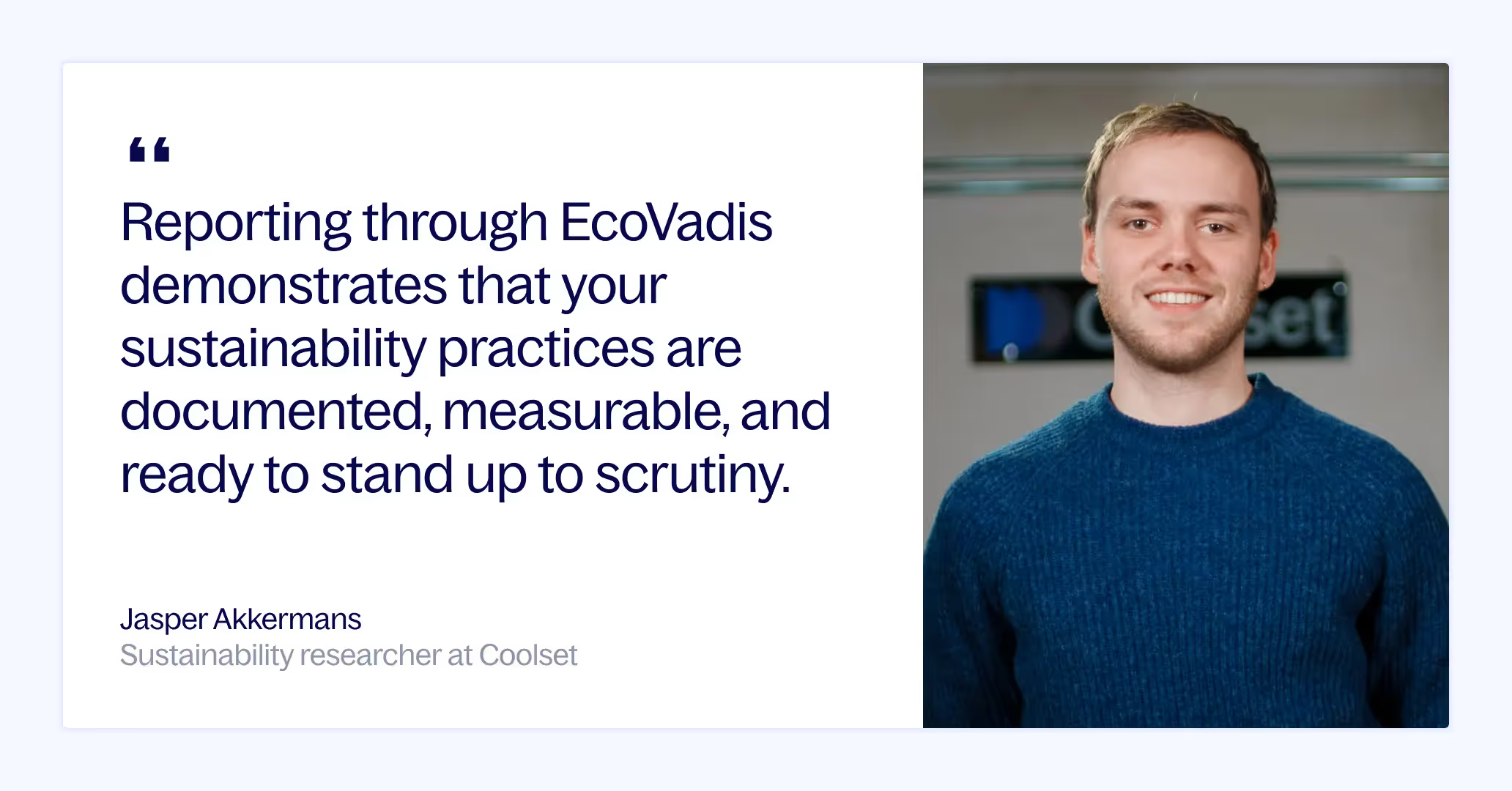
Completing the EcoVadis questionnaire can feel like juggling spreadsheets, shared drives, and endless email threads. Coolset brings structure to the chaos.
Designed for mid-sized companies managing sustainability reporting, it transforms EcoVadis preparation from an improvised, high-pressure task into a streamlined, repeatable workflow.
Most importantly, it lets you experiment, prepare, and improve without the stress of getting it right the first time – no time pressure, no costly submission, just a clear path to readiness.
Instead of hunting through folders or Slack messages, Coolset gives you a single source of truth. Documents are uploaded once, organized by EcoVadis theme and indicator, and mapped directly to the corresponding questionnaire. Everything sits in one structured library – so you always know what supports what.
Coolset guides you through each question with prompts, examples, and optional templates. Instead of guessing what EcoVadis wants, the platform shows you – step by step – how to respond with the right kind of evidence. If you’re missing a policy, Coolset can offer a starting template and tell you what needs to be included.
When you tag a document in Coolset – like a Code of Ethics or ISO certificate – the system can automatically flag related questions and suggest pre-filling answers. That means less duplication, faster input, and fewer gaps. It also alerts you to unanswered questions or missing documents before it’s too late.
EcoVadis submissions often involve multiple people. Coolset lets you assign questions, track progress, and leave comments all in one place. No more scattered spreadsheets or unclear responsibilities – just a live dashboard showing who’s doing what and where the bottlenecks are.
What you prepare for EcoVadis doesn’t live in a silo. Coolset helps you reuse the same data for other frameworks – like the Corporate Sustainability Reporting Directive (CSRD) or carbon disclosures. If you’ve already entered your emissions or labor data, there’s no need to do it again elsewhere. Coolset keeps your evidence mapped and ready.
Coolset is built for companies without full-time sustainability staff. The platform includes plain-language explanations, document templates, improvement tips, and when needed – access to expert help. It’s not just software; it’s structure, guidance, and clarity tailored for mid-market realities.
Coolset takes the EcoVadis questionnaire from a manual scramble to a repeatable system: collect → tag → fill → review → export. It helps ensure nothing important is missed, and that you spend less time chasing documents – and more time demonstrating impact.
To see how this works in action, book a demo of the Coolset EcoVadis platform and learn how to streamline your submission with built-in guidance, evidence mapping, and collaborative workflows. You can also request a walkthrough of our CSRD evidence mapping tool to prepare for broader ESG reporting – all from the same platform.
Answers to the most common questions from mid-sized companies tackling the EcoVadis assessment for the first time.
Start by collecting your documentation – policies, procedures, reports, metrics, and certifications. Then, work through the questionnaire by selecting only the options you can support with clear, dated evidence. Attach one document per selected option and use comment boxes to clarify anything that isn’t immediately obvious (e.g. page numbers or how the document applies).
Don’t claim what you can’t prove – unsupported answers won’t count. Involve relevant departments, double-check your inputs, and stay within the 55-document limit. Follow a structured process like the one in this guide and you’ll avoid missteps while saving time.
EcoVadis allows up to 55 supporting documents per assessment. To be accepted, documents must:
Accepted formats include PDF, Word, Excel, and PPT (PDF preferred). URLs are allowed but must be public and stable. If submitting in a less common language, include a short English summary. You can also mark files as confidential – EcoVadis analysts are bound by confidentiality, and clients won’t see evidence unless shared directly.
It depends. Some companies finish in a few days – others take several weeks. The biggest time factor is how prepared you are.
If your documents are ready and your team is aligned, filling out the questionnaire can take just a few days. Without preparation, the process stretches across weeks of document chasing and coordination. EcoVadis gives 30 business days by default. Many mid-sized firms use most of that time.
Pro tip: Create a shared document library, assign internal leads, and consider using tools like Coolset to reduce manual work and speed up completion.
EcoVadis evaluates your sustainability management across four key themes:
Each theme is scored out of 100 and weighted based on your industry. To earn a medal, you need strong, documented performance in all four. Any theme scoring below 30 makes your company ineligible for medals – so balance matters.
Platinum is EcoVadis’s highest medal, awarded to the top 1% of companies based on their scores. While it’s percentile-based, Platinum companies typically score in the high 70s or above – often 78 to 85+.
To aim for Platinum:
Platinum is a stretch goal – but achievable with consistent improvement, strong documentation, and a clean external profile.
360° Watch is EcoVadis’s external monitoring tool. It scans global media, NGO reports, government lists, and databases for any news – positive or negative – related to your company.
You don’t submit anything for 360° Watch. It’s managed independently by EcoVadis analysts and AI tools. But it still impacts your score:
The 360° Watch accounts for up to 20% of each theme score. It’s designed to ensure your internal documentation aligns with external reality. Operate transparently and address known risks – that’s the best way to stay on track.
Yes. To submit your questionnaire and receive a scorecard, you must choose an annual EcoVadis subscription plan. Here’s a quick breakdown:
You’ll be prompted to choose a plan at the submission stage. All plans include access to the platform, support, and the rating itself. If you want full visibility and actionable insights, Premium is the best fit for most mid-sized companies aiming for long-term improvement.
Tackling the EcoVadis questionnaire can feel complex – but with a clear strategy and the right tools, it becomes a manageable, even valuable, exercise. This guide has unpacked what the questionnaire really assesses, laid out step-by-step how to approach it, and flagged where mid-sized companies often stumble.
And you don’t have to do it alone. A platform like Coolset can cut the chaos – turning document sprawl into structured evidence, aligning teams, and giving you confidence in every answer.
Whether you're aiming for your first medal or a Platinum score, success starts with preparation and transparency. Show what you're doing, back it up with evidence, and use each assessment to keep raising the bar.
Ready to streamline your next submission? Book a demo and take the complexity out of EcoVadis.
Learn how to get a platinum score and everything you need to know about EcoVadis
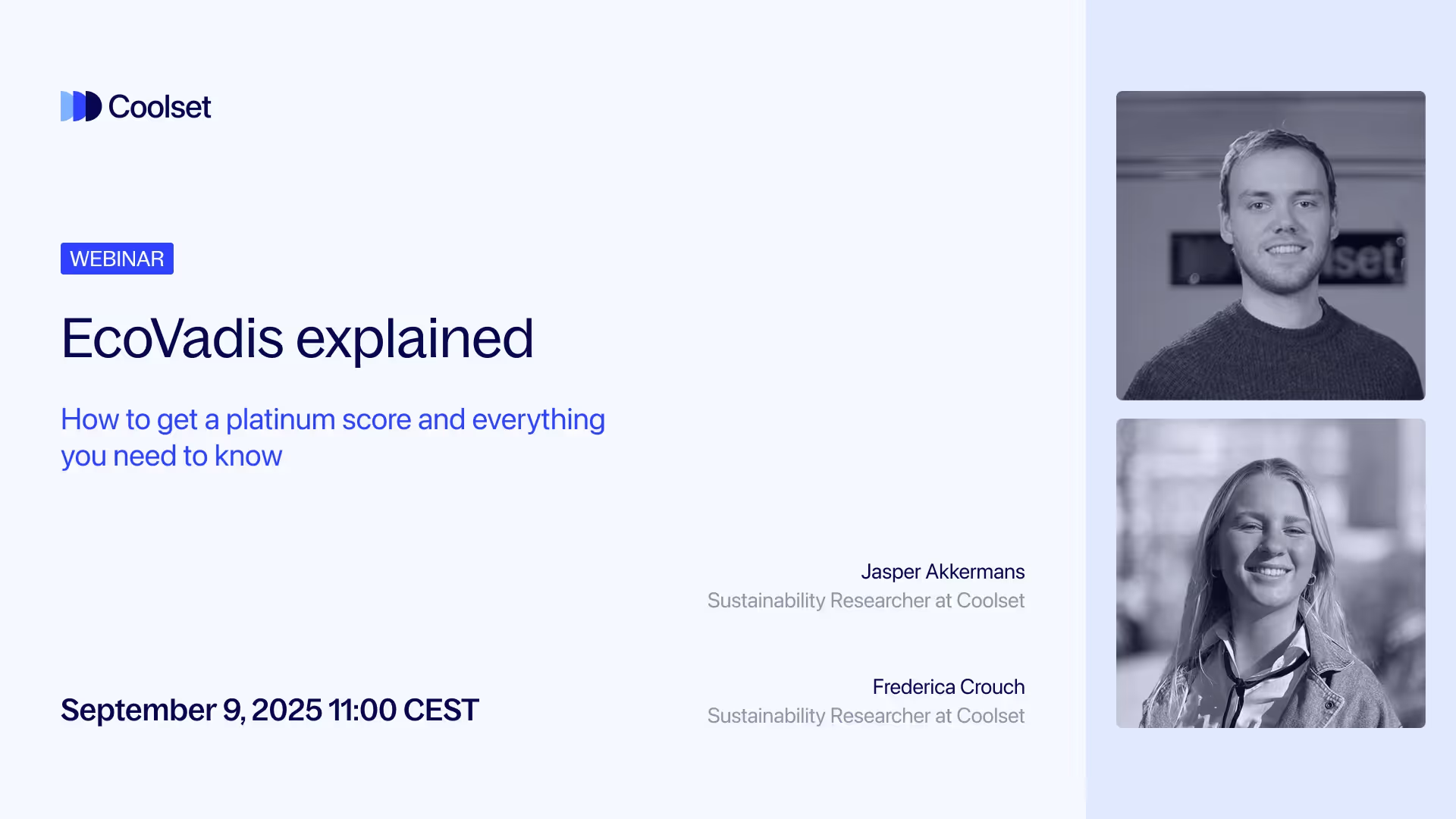
Centralize your EcoVadis data, organize your evidence and prepare your submission in one purpose-built platform.
